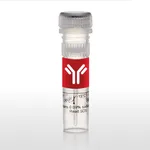Thermo Fisher Scientific delta-Opioid Receptor (OPRD1) (extracellular) Polyclonal Antibody
다른 상품 둘러보기
Applications
Tested Dilution
Publications
Western Blot (WB)
1:200
Immunohistochemistry (Frozen) (IHC (F))
1:100
Flow Cytometry (Flow)
2.5 µg
Product Specifications
Species Reactivity
Mouse, Rat
Host/Isotype
Rabbit / IgG
Class
Polyclonal
Type
Antibody
Immunogen
(C)ELVPSARAELQSSPLVN corresponding to amino acid residues 2-18 of mouse delta-Opioid receptor, Extracellular, N-terminus if (typeof window.$mangular === undefined || !window.$mangular) { window.$mangular = {}; } $mangular.antigenJson = \[{targetFamily:OPRD1,uniProtId:P32300-1,ncbiNodeId:10090,antigenRange:2-18,antigenLength:372,antigenImageFileName:AOR-014-200UL_OPRD1_P32300-1_Rabbit.svg,antigenImageFileNamePDP:AOR-014-200UL_OPRD1_P32300-1_Rabbit_PDP.jpeg,sortOrder:2}\]; $mangular.isB2BCMGT = false; $mangular.isEpitopesModalImageMultiSizeEnabled = true;
View immunogen .st0{fill:#FFFFFF;} .st1{fill:#1E8AE7;}
Conjugate
Unconjugated Unconjugated Unconjugated
Form
Lyophilized
Concentration
0.8 mg/mL
Purification
Antigen affinity chromatography
Storage buffer
PBS, pH 7.4, with 1% BSA
Contains
0.05% sodium azide
Storage conditions
-20° C, Avoid Freeze/Thaw Cycles
Shipping conditions
Ambient (domestic); Wet ice (international)
Product Specific Information
Reconstitution: 25 µL, 50 µL or 0.2 mL double distilled water (DDW), depending on the sample size. The antibody ships as a lyophilized powder at room temperature. Upon arrival, it should be stored at -20C. The reconstituted solution can be stored at 4C for up to 1 week. For longer periods, small aliquots should be stored at -20C. Avoid multiple freezing and thawing. Centrifuge all antibody preparations before use (10000 x g 5 min).
Target Information
OPRD1 is an Opioid Receptor that is involved in the control of anxiety, depression, and pain. It is a promising target in the therapy of mood-altering disorders and drug addiction. Delta and kappa opioid receptors function synergistically by forming heterodimers. OPRD1 expression has been reported primarily in the brain. High OPRD1 expression has been documented in the cortex, caudate, hippocampus, nucleus accumbens, and putamen; low OPRD1 expression has been identified in the cerebellum, hypothalamus, substantia nigra, and thalamus. OPRD1 expression is reduced in the putamen and amygdala of Alzheimers patients and in the putamen in Parkinsons disease.
For Research Use Only. Not for use in diagnostic procedures. Not for resale without express authorization.
배송/결제/교환/반품 안내
배송 정보
| 기본 배송비 |
| 교환/반품 배송비 |
|
|---|---|---|---|
| 착불 배송비 |
| ||
| 교환/반품 배송비 |
| ||
결제 및 환불 안내
| 결제수단 |
|
|---|---|
| 취소 |
|
| 반품 |
|
| 환급 |
|
교환 및 반품 접수
| 교환 및 반품 접수 기한 |
|
|---|---|
| 교환 및 반품 접수가 가능한 경우 |
|
| 교환 및 반품 접수가 불가능한 경우 |
|
교환 및 반품 신청
| 교환 절차 |
|
|---|---|
| 반품 절차 |
|

